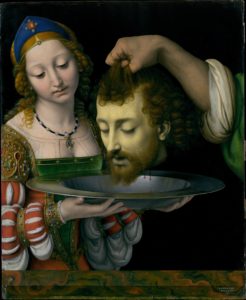Thoughts on Sunday’s Lessons for July 15, 2018

Salome with the Head of John the Baptist (1506-1507), oil painting by Andrea Solario (c.1465-c.1520). Metropolitan Museum of Art, New York. (Click image to enlarge.)
King David, now reigning over the two kingdoms of Israel and Judah, celebrates at the arrival in Jerusalem of the Ark of the Covenant. This shrine that the people had built in the desert as a holy throne for God was a central part of Israel’s worship. Its arrival was met with great celebration, music and dancing; David himself leaped and danced with all his might. In one curious, verse, though, we hear that David’s wife, Michal, saw him dancing and “despised him in her heart.” What was up with that? Later verses suggest that Michal, the daughter of Saul and sister of Jonathan, both of whom had recently died, didn’t think that David was decently dressed during his dance in front of all the people of Israel.
First Reading (Track Two): Amos 7:7-15
As the Prophet Amos and John the Baptist both learned, prophesying can get you in trouble, even when you’re just repeating God’s message. Amos, a humble shepherd and sycamore tender, never expected to become a prophet. But he responded when God called him to warn Israel’s leaders that their God had measured them and found them wanting. When Amos warned King Amaziah to expect destruction and exile, the angry King told Amos to get out of his sight, to go back where he came from. Amos learned, as John the Baptist would discover some six centuries later, that prophecy was dangerous and could get him killed. But both heard God’s call and could not refuse.
Psalm (Track One): Psalm 24
Today’s Psalm, one of the many that tradition attributes to King David himself, is thought to have been intended as a processional chant as the priests and congregation approach the Temple. The priest calls out, “And who shall stand in his holy place? Who has the right to come in and worship? “Those who have clean hands and pure hearts,” the crowd sings back, awaiting the protection of God, the King of Glory, creator of the earth and all that is in it. (We’ll hear this Psalm again on All Saints Day this year.)
Psalm (Track Two): Psalm 85:8-13
This beautiful Psalm segment offers a gentle pause between the anger in Amos and the violence of John the Baptist’s death. God will speak peace to the people; the faithful people will hear peace. When Heaven and earth meet in truth and righteousness, righteousness and peace share a tender kiss. God grants prosperity and a fruitful harvest, truth springs up, and righteousness goes before.
Second Reading: Ephesians 1:3-14
After almost two months with Second Corinthians, our second readings now turn for the next six weeks to the letter to the Ephesians. A letter most likely written to the people of Ephesus in Paul’s name by a later follower around the end of the first century, it speaks to an early Christian community that faced persecution. Some of its chapters include “difficult” passages (which we won’t hear in our readings this year) that urge wives to submit to their husbands and slaves to obey their owners. Today’s reading, though, from the introductory verses, focus on grace as God’s free gift through Jesus. We also catch a glimpse of an evolving theology that Christ was present with God even before the creation of the Earth.
Gospel: Mark 6:14-29
When evil King Herod learned about the healings and miracles that Jesus and his apostles were performing up in Galilee, he was likely both angry and afraid. In a quick Gospel flashback, Mark recalls the gory story about Herod, at the insistence of his new wife and her daughter, ordering John beheaded and his head brought in on a platter. Now that rumors are swirling about Jesus and his activity in Galilee, people are wondering if Jesus is John, brought back to life. Herod is afraid. “John, whom I beheaded, has been raised.”
What are “Track 1” and “Track 2”?
During the long green season after Pentecost, there are two tracks (or strands) each week for Old Testament readings. Within each track, there is a Psalm chosen to accompany the particular lesson.
The Revised Common Lectionary allows us to make use of either of these tracks, but once a track has been selected, it should be followed through to the end of the Pentecost season, rather than jumping back and forth between the two strands.
For more information from LectionaryPage.net, click here.
